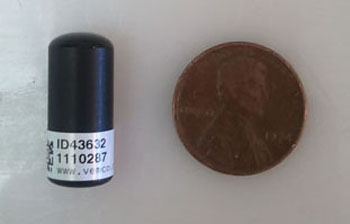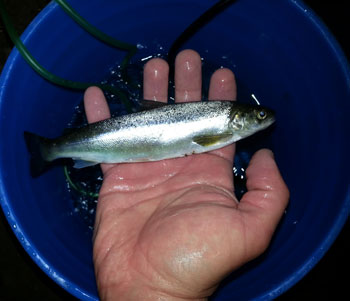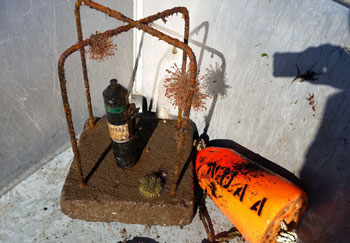Restoring Atlantic Salmon to the Narraguagus
Continued from Homepage

The implanted tags used by NOAA Fisheries are roughly the size of a Jolly Rancher candy, and getting smaller all the time. Though the battery life on these transmitters will only last 3-4 months, Hawkes said there are firms developing tags that recharge themselves by the motion of the fish’s tail. Photo courtesy NOAA FIsheries.
The Narraguagus is one of those rivers, and the collaborative efforts of state, federal, nonprofit and even commercial partners are focused on bringing the Atlantic salmon back to this Washington County river, once renowned for its plentiful springtime salmon runs.
Ernie Atkinson is the Maine Department of Marine Resources (DMR) Wildlife Biologist dedicated to salmon restoration Downeast. Using fish raised at the U.S. Fish and Wildlife Service Green Lake National Fish Hatchery in Ellsworth, Atkinson and the DMR team released 100,000 salmon smolts into the Narraguagus in 2016.
“This year is the year we expect the bulk of them [to return],” said Atkinson. “We’re ahead of the game where we were last year at this point.” As of mid-July the DMR counted 36 of those 100,000 smolts coming back up the Narraguagus to spawn.
“Ocean survival is pretty tough,” said Atkinson, noting most smolt mortality occurs after the fish leave the river. In 2011 the DMR saw their last big year which brought 3,000 fish back to the Penobscot and more than 100 to the Narraguagus. “Things were optimal. Whether it was temperatures or food or all the predators were sleeping.”
“We’re hoping for more of those years but it’s one of those things,” said Atkinson. “It’s a wait-and-see game.”
Based on previous stocking data, 12 salmon return for every 10,000 smolt stocked. Therefore of the 100,000 smolts in the 2016 cohort, the DMR hopes to welcome 120 new residents back to the Narraguagus. For wild-reared salmon the return numbers are significantly higher. Studies show roughly 62 fish return to their home river for every 10,000 smolts counted.

A transmitter-tagged hatchery smolt raised at U.S. Fish and Wildlife’s Green Lake National Fish Hatchery, Ellsworth, Maine. The Maine Department of Marine Resources stocked 100,000 of these smolts in the Narraguagus River in 2016 and are now beginning to see the first “two sea winter” smolts returning to spawn. Photo courtesy NOAA Fisheries.
“Wild fish outperform hatchery fish. Their life history is different,” said Jim Hawkes, who works closely with Atkinson in his role as a research fishery biologist on NOAA Fisheries Atlantic Salmon Ecosystems Research Team.
One of Hawkes’ specialties is “smolt telemetry,” using surgically-implanted transmitters to track salmon after they’re stocked in the Narraguagus. “Each of these transmitters emits a unique, coded signal so we are able to describe, in part, individual experiences during their migration,” said Hawkes.
As the fish travel from the upper reaches of the river, their transmitters’ signals are read by 40 receivers instream within the river, estuary, and into the Narraguagus Bay.
The transition between freshwater and saltwater is a perilous one for the smolts. “It’s a novel environment for them,” said Hawkes. While the fish adapt to changes in temperature and water they’re encountering increased threats from new predators that lurk in and around estuary waters.
Once clear of the estuary and bay telemetry network, some smolts will be detected by receivers on oceanographic buoys in the Gulf of Maine, and some may even be detected by Canadian receivers off Halifax, Nova Scotia as they progress toward Newfoundland and their destination of feeding grounds off the west coast of Greenland.
The transmitter data has shown most smolts take between four and 10 days to travel the river, a distance of 50 kilometers, and they have a tendency to move more at night. “We learn more about behaviors of the fish, what routes they take,” said Hawkes. The transmitter research helps describe success of stocking strategies, but also informs managers when bridge repairs and maintenance can take place, and where new projects (tidal, wind, etc) can be considered to lessen impact on fish movement and survival.
“They provide a lot of information, and we certainly put that into use for our stocking decisions,” said Atkinson.
But on the other end of well-researched stocking, there still has to be a suitable habitat for salmon to return to and spawn. “Not all habitat is equal,” said Hawkes. “You can’t spawn in a high-silt environment and expect your young to thrive.”

Forty of these telemetry receivers are placed in the Narraguagus River waiting for a tagged smolt to pass. It will then record the “ping” from the tag, helping NOAA scientists learn more about the migratory habits of stocked Atlantic salmon smolts. Photo courtesy NOAA Fisheries.
Enter Project SHARE, an Eastport-based nonprofit dedicated to salmon habitat restoration. SHARE stands for Salmon HAbitat River Enhancement. The nonprofit was formed in 1994.
“Ripples and pools are good habitat for fish, they don’t automatically just happen,” said Project SHARE’s Executive Director Steven Koenig. “You have to have natural dynamics in the river to form them.”
SHARE tackles two primary obstacles to good river habitat — road-stream crossings and inadequate “stream complexity,” largely owing to changes made during the log-drive era.
“During the log-drive era the river channel was the transportation mechanism to get wood down the river to the mills,” said Koenig, “and so to facilitate those drives anything that was blocking flow was manually removed.”
Salmon and aquatic insects like to find dark, cool places to hide. When rivers were straightened and obstacles removed, said Koenig, the currents began to distribute silt evenly, filling in those desirable nooks and crannies. “The bed of a river is supposed to move,” he said.
“Atlantic Salmon prefer little habitats, and shift to deeper habitats in wintertime, provided there’s substrate,” said Atkinson.
Project SHARE started by placing trees in smaller tributaries to create natural barriers in the water. Now they’re working at the top of the Narraguagus placing PALS, or Post Assisted Log Structures. Koenig hopes these wooden barriers last a little longer than trees, which tend to wash downstream during high water events. Current moves more quickly around the barriers, which helps create a more desirable riverbed for salmon.
Even in light of recent progress, Hawkes keeps a pragmatic eye to the future.
“The ultimate goal of hatchery operation is to maintain the stock until something changes and improves, until the species rebounds,” he said. “We’re just trying to help them along by discovering where losses occur and what we can do about it.” There are some factors, such as climate change, that can’t be addressed in the near term.
Koenig takes a similar view. “If you did not have those hatcheries, Atlantic salmon would be extinct in the United states. Those hatcheries are like the lifeboat.”
“If it was simple we would have restored the populations with the effort we’ve put forward, “ said Hawkes. “You’ve just got to maintain that constant effort with hopes that something’s going to change.”
